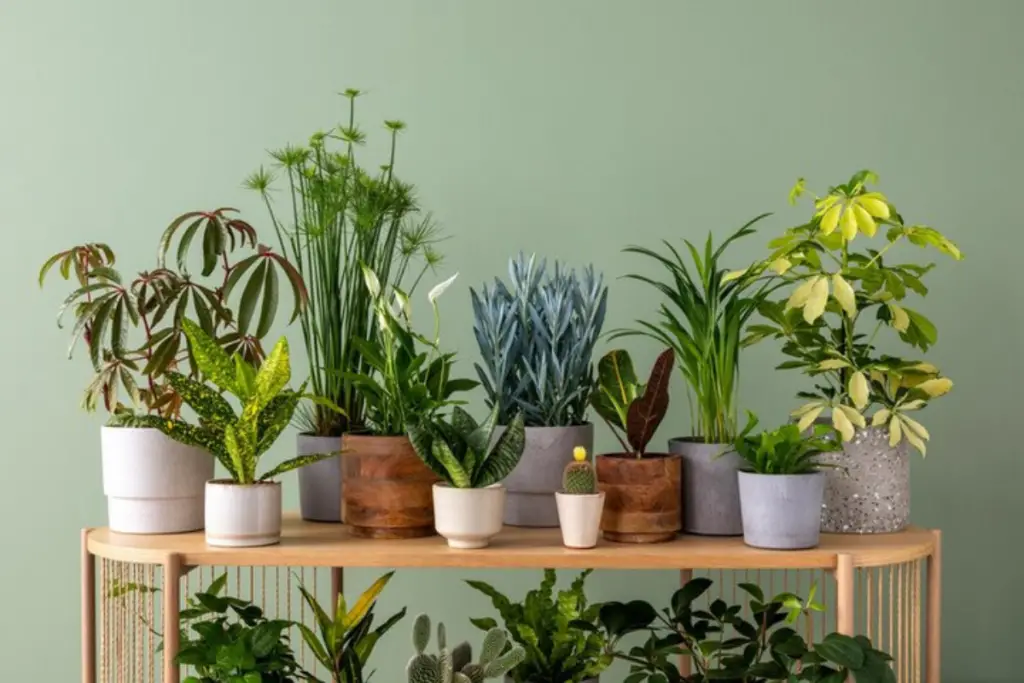Indoor plants are not only great for adding a touch of nature to one’s living space, but they can also help improve indoor air quality.
In fact, studies have shown that certain indoor plants can help purify the air by removing harmful pollutants and toxins.
If you’re looking to improve the air quality in your home or office, here are the top 5 indoor plants for air purification.
These plants have been shown to be highly effective at removing common indoor air pollutants such as formaldehyde, benzene, and trichloroethylene.
- Spider Plant – This easy-to-care-for plant is great for beginners and is highly effective at removing formaldehyde from the air.
- Peace Lily – This beautiful plant not only adds a touch of elegance to any room, but it’s also great at removing harmful pollutants such as benzene and trichloroethylene.
- Snake Plant – Also known as mother-in-law’s tongue, this plant is highly effective at removing formaldehyde and other toxins from the air.
- Bamboo Palm – This plant is great for adding a tropical touch to your living space, and it’s also highly effective at removing harmful pollutants such as benzene and trichloroethylene.
- Aloe Vera – Not only is this plant great for soothing sunburns, but it’s also highly effective at removing formaldehyde from the air.

Table of Contents
What are Indoor Plants for Air Purification?
Indoor plants are a great way to enhance the beauty of your home or office. Besides adding aesthetic value, some indoor plants are known for their air-purifying properties.
These plants are capable of removing harmful toxins and pollutants from the air, thereby improving the overall air quality.
Indoor plants for air purification work by absorbing harmful chemicals through their leaves and roots.
They then convert these pollutants into harmless compounds which are used for their growth and development.
Some of the common toxins that indoor plants can remove from the air include formaldehyde, benzene, trichloroethylene, and carbon monoxide.
There are several indoor plants that are known for their air-purifying properties. Some of the most popular ones are:
- Spider Plant – This plant is known for its ability to remove formaldehyde and xylene from the air. It is easy to grow and requires minimal care.
- Peace Lily – The Peace Lily is known for its ability to remove formaldehyde, benzene, and trichloroethylene from the air. It is also a great plant for those who have allergies or asthma.
- Dracaena – The Dracaena plant is known for its ability to remove benzene, formaldehyde, trichloroethylene, and xylene from the air. It is a low-maintenance plant that can grow up to 6 feet tall.
- Snake Plant – The Snake Plant is known for its ability to remove formaldehyde and benzene from the air. It is also known for its ability to release oxygen at night, making it a great plant for the bedroom.
- Bamboo Palm – The Bamboo Palm is known for its ability to remove formaldehyde, benzene, and trichloroethylene from the air. It is also a great plant for those who have pets as it is non-toxic to cats and dogs.
In conclusion, indoor plants for air purification are a great way to improve the air quality in your home or office.
They are easy to care for and can provide several health benefits. By adding these plants to your living space, you can create a healthier and more beautiful environment.
Top 5 Indoor Plants for Air Purification
Indoor plants not only add beauty to your living space but also help in purifying the air. According to a NASA study, certain indoor plants can remove harmful toxins such as formaldehyde, benzene, and carbon monoxide from the air.
Here are the top 5 indoor plants for air purification:
1. Snake Plant
Also known as Mother-in-law’s Tongue, the Snake Plant is a low maintenance plant that is perfect for beginners.
It is known for its ability to remove formaldehyde, trichloroethylene, and benzene from the air. The plant grows well in indirect light and does not require frequent watering.
2. Peace Lily
The Peace Lily is a popular indoor plant that is known for its ability to remove toxins such as formaldehyde, benzene, and carbon monoxide from the air.
The plant also adds moisture to the air, making it ideal for dry environments. The Peace Lily requires low to medium light and should be watered once a week.
3. Spider Plant
The Spider Plant is another low maintenance plant that is perfect for beginners. It is known for its ability to remove formaldehyde, benzene, and carbon monoxide from the air.
The plant grows well in bright, indirect light and should be watered once a week.
4. Aloe Vera
Aloe Vera is a popular plant that is known for its ability to soothe burns and cuts. However, it is also an excellent air purifier.
The plant removes formaldehyde and benzene from the air, making it ideal for homes with smokers. Aloe Vera requires bright, indirect light and should be watered once a week.
5. English Ivy
English Ivy is a popular plant that is known for its ability to remove formaldehyde from the air. It is also effective in removing other pollutants such as benzene and xylene.
The plant grows well in low to medium light and should be watered once a week.
Overall, these indoor plants are not only aesthetically pleasing but also beneficial for your health. They purify the air and add moisture, making your living space healthier and more comfortable.
How do indoor plants purify the air?
Indoor plants have been shown to be effective in removing harmful pollutants from the air. They do this through a process called phytoremediation, which involves the absorption, breakdown, and metabolization of harmful chemicals by the plant.
This process is made possible by the presence of tiny microbes in the soil surrounding the plant’s roots.
Plants are able to purify the air by removing toxins such as formaldehyde, benzene, and trichloroethylene.
Formaldehyde is a common indoor air pollutant that can be found in many household items such as furniture, carpets, and cleaning products.
Benzene is a carcinogen that can be found in gasoline, plastics, and synthetic fibers. Trichloroethylene is a toxic chemical that can be found in solvents, paints, and adhesives.
Through the process of photosynthesis, plants convert carbon dioxide into oxygen, which is essential for human life.
They also absorb other gases from the air, such as nitrogen dioxide and sulfur dioxide. This helps to improve the overall air quality in the room.
Different plants are more effective at removing different pollutants. For example, the spider plant is particularly effective at removing formaldehyde, while the peace lily is known to be effective at removing benzene.
The snake plant is effective at removing nitrogen oxide and formaldehyde, while the bamboo palm is known to be effective at removing trichloroethylene.
In general, the bigger the plant and the leafier the plant, the better it is at purifying the air. However, it is important to note that while indoor plants can help to improve air quality, they are not a substitute for proper ventilation and air filtration systems.
Conclusion
In conclusion, indoor plants can be an effective and natural way to purify the air in your home or office.
By adding just a few plants to your space, you can reduce the amount of harmful toxins and pollutants in the air, and improve your overall health and well-being.
Based on the research and analysis, the top 5 indoor plants for air purification are:
- Spider Plant
- Snake Plant
- Peace Lily
- Bamboo Palm
- Dracaena
These plants are not only effective at removing harmful pollutants from the air, but they are also easy to care for and can thrive in a variety of indoor environments.
It’s important to note that while indoor plants can be beneficial for air purification, they should not be relied upon as the sole method for improving indoor air quality.
Other factors such as proper ventilation, regular cleaning, and avoiding the use of harmful chemicals and materials should also be taken into consideration.
Overall, adding indoor plants to your space can be a simple and effective way to improve the air quality and create a healthier, more comfortable environment.
- How to Build a Planter Box for Bamboo: A Step-by-Step Guide

- Can Robotic Lawnmowers Handle Steep Slopes?

- Do You Need a Specific Lawn for a Robotic Lawnmower? Expert Advice

- Are Robotic Lawnmowers Safe for Pets and Children? Safety Features of Robotic Lawnmowers

- Why Use Robotic Lawnmowers? Advantages of Using a Robotic Lawnmower

- Is the GARDENA SILENO City 300 Cordless or Corded? A Clear Answer














